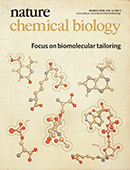Advertisement |
 |
- 1,280 pharmacologically active compounds
- Ready-to-use DMSO stocks: less time-consuming sample preparation
- Highly pure compounds with full QC: re-supply as individual catalog items
Learn More |  | | |
 |
 |
TABLE OF CONTENTS
|
March 2018 Volume 14, Issue 3 |
 |  |  |
 |  Editorial Editorial
 Commentaries Commentaries
 Research Highlights Research Highlights
 News and Views News and Views
 Perspectives Perspectives
 Reviews Reviews
 Brief Communication Brief Communication
 Articles Articles
 Erratum Erratum
|  | Advertisement |  |  |  |  Nature Catalysis is an online-only journal that publishes research, review and comment across all areas of catalysis. Nature Catalysis is an online-only journal that publishes research, review and comment across all areas of catalysis.
EXPLORE THE LATEST ISSUE >> | | |
|
|
 |
|
 |
 |
Advertisement |
 |
Nature Research 'lab health' survey 2018
The Nature Research's lab health survey aims to find out what makes a research group supportive, productive, and rigorous. The survey should take 10 to 15 minutes to complete and you'll have the chance to win a £100/$150 Amazon gift card. Your entries will be confidential and results will be featured in Nature.
Complete the survey today >> |  | | |
 |
| |
| Advertisement |
 |
| |
 |
| |
Editorial |  Top Top |
 |
 |
 |
Altering form for function p187
doi:10.1038/nchembio.2582
Elucidating the mechanisms by which biomolecules are chemically modified and how these alterations regulate biological pathways represents a leading frontier in chemical biology.
|
 |
Commentaries |  Top Top |
 |
 |
 |
The ABCs of PTMs pp188 - 192
Karl W Barber and Jesse Rinehart
doi:10.1038/nchembio.2572
Post-translational modifications (PTMs) are ubiquitous in all forms of life and often modulate critical protein functions. Recent chemical and biological advances have finally enabled scientists to precisely modify proteins at physiologically relevant positions, ushering in a new era of protein studies.
|
 |
 |
 |
Covalent modifications of polysaccharides in mycobacteria pp193 - 198
Shiva k Angala, Zuzana Palcekova, Juan M Belardinelli and Mary Jackson
doi:10.1038/nchembio.2571
Mycobacteria produce carbohydrates of exceptional structures that are covalently modified by unique substituents, whose functional characterization could expand our understanding of how mycobacteria adapt to their environment.
|
 |
Research Highlights |  Top Top |
 |
 |
 |
Lipids: Picturing palmitoylation | Viruses: Capsids under pressure | Glycosylation: Gluing on glycans | Ubiquitination: Trashing the CIA
|
News and Views |  Top Top |
 |
 |
 |
| |
 |
Perspectives |  Top Top |
 |
 |
 |
How many human proteoforms are there? pp206 - 214
Ruedi Aebersold, Jeffrey N Agar, I Jonathan Amster, Mark S Baker, Carolyn R Bertozzi et al.
doi:10.1038/nchembio.2576
|
 |
 |
 |
Distinguishing RNA modifications from noise in epitranscriptome maps pp215 - 225
Anya V Grozhik and Samie R Jaffrey
doi:10.1038/nchembio.2546
|
 |
Reviews |  Top Top |
 |
 |
 |
Structural and evolutionary insights into ribosomal RNA methylation pp226 - 235
Petr V Sergiev, Nikolay A Aleksashin, Anastasia A Chugunova, Yury S Polikanov and Olga A Dontsova
doi:10.1038/nchembio.2569
|
 |
 |
 |
Insights into the biogenesis, function, and regulation of ADP-ribosylation pp236 - 243
Michael S Cohen and Paul Chang
doi:10.1038/nchembio.2568
|
 |
 |
 |
Features and regulation of non-enzymatic post-translational modifications pp244 - 252
Robert Harmel and Dorothea Fiedler
doi:10.1038/nchembio.2575
|
 |
Brief Communication |  Top Top |
 |
 |
 |
|
 |
| Advertisement |
 |
Do you have a career question?
The Naturejobs podcast features one-on-one Q&As, panel discussions and other exclusive content to help scientists with their careers. Hosted on the Naturejobs blog, the podcast is also available on iTunes and Soundcloud.
Listen today! |  | | |
 |
| |
Articles |  Top Top |
 |
 |
 |
|
 |
 |
 |
|
 |
 |
 |
|
 |
 |
 |
|
 |
 |
 |
|
 |
 |
 |
|
 |
 |
 |
|
 |
 |
 |
|
 |
 |
 |
|
 |
 |
 |
|
 |
| Advertisement |
 |
| |
 |
| |
Erratum |  Top Top |
 |
 |
 |
Light-activated chemical probing of nucleobase solvent accessibility inside cells p325
Chao Feng, Dalen Chan, Jojo Joseph, Mikko Muuronen, William H Coldren et al.
doi:10.1038/nchembio0318-325
|
 |
 Top Top |
 |
 |
| Advertisement |
 |
nature.com webcasts
Join us for our upcoming webcast with live Q&A:
FIGHTING INFECTIOUS DISEASES
Presented by BioPharma Dealmakers
Date: Tuesday, February 27, 2018
Time: 8AM PST, 11AM EST, 4PM GMT, 5PM CET
REGISTER FOR FREE
Sponsored by: PaxVax, Inc., NovaBiotics Ltd, Wellcome | | | |
 |
| |
 |  |  |  |  |  | Natureevents is a fully searchable, multi-disciplinary database designed to maximise exposure for events organisers. The contents of the Natureevents Directory are now live. The digital version is available here.
Find the latest scientific conferences, courses, meetings and symposia on natureevents.com. For event advertising opportunities across the Nature Publishing Group portfolio please contact natureevents@nature.com |  |  |  |  |  |
|
 |


No comments:
Post a Comment